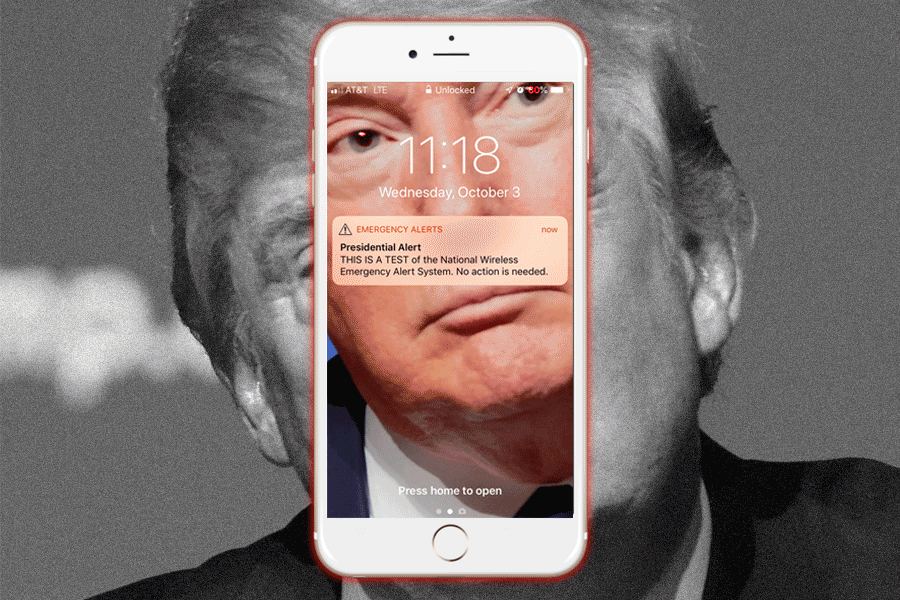It happened. At 11:21 am PST (three minutes later than it was scheduled), you received your first Presidential Alert. Maybe you were waiting around for it all morning. Probably, you were already on your phone. Hopefully you were taking a shit. Either way, when you first heard about the Presidential Alert, you maybe thought it sounded suspiciously similar to a presidential tweet, but for now, it’s not the same thing.
Tiffany Trump Receives First Ever Text From Father https://t.co/GRuTbsKfTF
— The Hard Times (@REALpunknews) October 3, 2018
The test, which was conducted by the Federal Emergency Management Agency (FEMA) was a nationwide test of its Wireless Emergency Alerts (WEA). In other words, every American who owns a smartphone — about 75 percent of the population — received the alert. But unlike emergency alerts and AMBER alerts, these presidential alerts cannot be turned off, according to FEMA.
Let’s find out more!
So how come the government is allowed to do this?
“‘The Communications Act of 1934 established the authority for the president to use certain private sector communications systems for priority communications, such as sending alert and warning messages to the public, during national emergencies,’ said FEMA in a FAQ explaining the test,” reported USA Today. Depending on your political affiliation, it may help you to know that the message was a test of a warning system created under the Obama administration in 2016, designed to alert the public about national emergencies.
Now that I’m 10 percent reassured that the president can’t blast his tweets directly to my phone, how does the Presidential Alert System actually work?
According to The Washington Post, only wireless emergency alert-compatible cell phones (likely anything that isn’t the kind of phone you’d find in an Amish village) that are switched on and within range of an active cell tower will be capable of receiving the test alert. “The national test will use the same special tone and vibration as with all WEA messages, such as those for tornado warnings or AMBER alerts,” FEMA said,” reports The Washington Post.
Okay, but what constitutes a national emergency?
A different article in the Washington Post reports that the presidential alert is designed to let the White House inform the entire country almost instantly of grave public emergencies, “such as a terrorist attack or an invasion, according to the Federal Emergency Management Agency,” reports Brian Fung.
But if you’re still feeling a iffy about anything dubbed a “presidential alert,” this next bit of information is only going to make things worse: Time reports that while FEMA will be responsible for tests and exercises of the system, the president has sole responsibility for assessing when the emergency alert system will be activated.
So you’re saying there’s a chance that Trump could deem one of his 6 a.m. tweets a national emergency and blast it through to my phone using this system?
Not exactly. The Integrated Public Alert and Warning System Modernization Act of 2015 specifically states that the warning system must only be used to to alert the public of a potential disaster, which means if Trump uses the alert system to let the country know that he’s the greatest president in the history of humankind, he’d be breaking the law.
But he breaks the law basically every other week, so what’s stopping him from abusing the presidential alert system?
In a word: Complexity (breathes sigh of relief). According to the same Time article, the process is way more complex than drafting an ungrammatical tweet and hitting send. “There are very specific guidelines for what the message must contain and the president himself will not draft the message, he will simply authorize a staff member to send it out on his behalf, according to FEMA,” reports Time.
Of course, the simple fact that the system is slightly more complex than drafting a tweet didn’t stop several dramatic types from threatening to turn off their cell phones during the scheduled alert:
I want to opt out immediately. I do not want to hear @realDonaldTrump on my phone…ever
— Steffie ? (@queenmumzy) September 16, 2018
@TMobile I don’t want this. I know the article says we can’t opt out of “presidential alerts” but I’m sure you guys can figure it out.
— Dani Moinet (@RadiantSolstice) September 16, 2018
— Trueblue (@ponymom48) September 16, 2018
Which may be the only true way to evade it. As explained above, if your phone is turned on, you can’t avoid receiving the alert. This explains why earlier in the week, a woman in New York filed a lawsuit against Trump and FEMA, calling the Presidential Alert System a violation of First and Fourth Amendment rights. “The suit states the definitions of ‘threat to public safety’ and ‘act of terrorism’ in the act don’t clearly define when it can be used, opening the door for officials such as President Trump to define it as they see fit and potentially ‘broadcasting arbitrary, biased, irrational and/or content-based messages to hundreds of millions of people,’” reports Fox17.
And really… she has a point.

